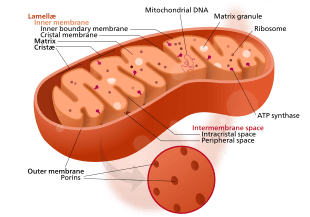Mitochondrial ribosome
Mitochondrial ribosome or mitoribosome is a protein complex that is active in mitochondria and functions as a riboprotein for translating mitochondrial mRNAs encoded in mtDNA. Mitoribosomes, like cytoplasmic ribosomes, consist of two subunits — large (mtLSU) and small (mt-SSU).[1] However, the ratio of rRNA/protein is different from cytoplasmic ribosomes, mitoribosomes consist of several specific proteins and less rRNAs.[1]

Function
Mitochondria contain around 1000 proteins in yeast and 1500 proteins in humans; however only 8 and 13 proteins are encoded in mitochondrial DNA in yeast and human, respectively. Most mitochondrial proteins are synthesized via cytoplasmic ribosomes.[2] Proteins that are the key components in the electron transport chain are translated in mitochondria.[3][4]
Structure
Mammalian mitoribosomes have small 28S and large 39S subunits, together forming a 55S mitoribosome.[5]
Genes
- MRPS1, MRPS2, MRPS3, MRPS4, MRPS5, MRPS6, MRPS7, MRPS8, MRPS9, MRPS10, MRPS11, MRPS12, MRPS13, MRPS14, MRPS15, MRPS16, MRPS17, MRPS18, MRPS19, MRPS20, MRPS21, MRPS22, MRPS23, MRPS24, MRPS25, MRPS26, MRPS27, MRPS28, MRPS29, MRPS30, MRPS31, MRPS32, MRPS33, MRPS34, MRPS35
- MRPL1, MRPL2, MRPL3, MRPL4, MRPL5, MRPL6, MRPL7, MRPL8, MRPL9, MRPL10, MRPL11, MRPL12, MRPL13, MRPL14, MRPL15, MRPL16, MRPL17, MRPL18, MRPL19, MRPL20, MRPL21, MRPL22, MRPL23, MRPL24, MRPL25, MRPL26, MRPL27, MRPL28, MRPL29, MRPL30, MRPL31, MRPL32, MRPL33, MRPL34, MRPL35, MRPL36, MRPL37, MRPL38, MRPL39, MRPL40, MRPL41, MRPL42
References
- Alexey Amunts; Alan Brown; Jaan Toots; Sjors H. W. Scheres; V. Ramakrishnan (2015). "Ribosome. The structure of the human mitochondrial ribosome". Science. 348 (6230): 95–98. doi:10.1126/science.aaa1193. PMC 4501431. PMID 25838379.
- Wenz, Lena-Sophie; Opaliński, Łukasz; Wiedemann, Nils; Becker, Thomas (2015). "Cooperation of protein machineries in mitochondrial protein sorting". Biochimica et Biophysica Acta (BBA) - Molecular Cell Research. 1853 (5): 1119–1129. doi:10.1016/j.bbamcr.2015.01.012. ISSN 0167-4889. PMID 25633533.
- Johnston, Iain G.; Williams, Ben P. (2016). "Evolutionary Inference across Eukaryotes Identifies Specific Pressures Favoring Mitochondrial Gene Retention". Cell Systems. 2 (2): 101–111. doi:10.1016/j.cels.2016.01.013. ISSN 2405-4712. PMID 27135164.
- Hamers, Laurel (2016). "Why do our cell's power plants have their own DNA?". Science. doi:10.1126/science.aaf4083. ISSN 0036-8075.
- Basil J. Greber; Philipp Bieri; Marc Leibundgut; Alexander Leitner; Ruedi Aebersold; Daniel Boehringer; Nenad Ban (2015). "Ribosome. The complete structure of the 55S mammalian mitochondrial ribosome". Science. 348 (6232): 303–308. doi:10.1126/science.aaa3872. hdl:20.500.11850/100390. PMID 25837512.